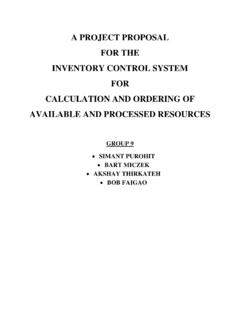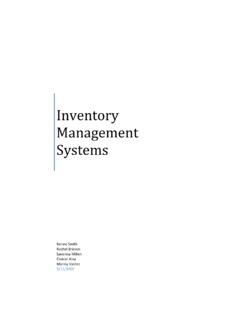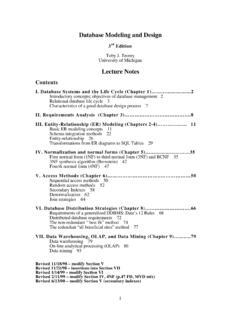Transcription of LAB MANUAL FOR DATABASE MANAGEMENT SYSTEM …
1 JNTU World LAB MANUAL . ld FOR. or DATABASE MANAGEMENT . WSYSTEM. TU. JN. Downloaded From JNTU World ( ). JNTU World CSE- 216 E DATABASE MANAGEMENT Systems Lab L T P Class Work: 25. - - 2 Exam: 25. Total: 50. Duration of Exam: 3. Hrs. ld I. Create a DATABASE and write the programs to carry out the following operation : 1. Add a record in the DATABASE 2. Delete a record in the DATABASE or 3. Modify the record in the DATABASE 4. Generate queries 5. Generate the report 6. List all the records of DATABASE in ascending order. II Develop a menu driven project for MANAGEMENT of DATABASE SYSTEM : W.
2 1. Library information SYSTEM (a) Engineering (b) MCA. 2. inventory control SYSTEM (c) Computer Lab (d) College Store TU. 3. Student information SYSTEM (e) Academic (f) Finance 4. Time table development SYSTEM (g) CSE, IT & MCA Departments (h) Electrical & Mechanical Departments JN. Usage of S/w: 1. VB, ORACLE and/or DB2. 2. VB, MSACCESS. 3. ORACLE, D2K. 4. VB, MS SQL SERVER 2000. Note: At least 5 to 10 more exercises to be given by the teacher concerned. Downloaded From JNTU World ( ). JNTU World Rational behind DBMS Lab ld DATABASE MANAGEMENT has evolved from a specialized computer application to a central component of a modern computing environment and as a result knowledge about DATABASE SYSTEM has become an essential part of computer science.
3 The course serves as a visual guide to the material presented during our lectures. The aim of this course is to provide an introduction to DATABASE MANAGEMENT SYSTEM , with an emphasis on foundational material or The fundamental concepts and algorithms covered are based on those used in existing commercial or experimental DATABASE systems. Our aim is to present these concepts and algorithms in general setting. Objectives W. At the end of the course students should 1 have a good understanding of how several fundamental algorithms work, particularly those concerned with creation and updating of tables.
4 2 have a good understanding of the fundamental DBMS used in computer science 3 be able to understand various queries and their execution. TU. 4 be able to design new DATABASE and modify existing ones for new applications and reason about the efficiency of the result JN. Downloaded From JNTU World ( ). JNTU World Software and Hardware Requirements Software Required: ld 1. VB, ORACLE and/or DB2. 2. VB, MSACCESS. 3. ORACLE, D2K. 4. VB, MS SQL SERVER 2000. or Hardware Required: Processor : Pentium III. RAM : 128 MB. Hard Disk : 40 GB.
5 W. TU. JN. Downloaded From JNTU World ( ). JNTU World Theory and Concept Practical #1. Objective: Create tables and specify the Questionnaires in SQL. Theory & Concepts: Introduction about SQL- ld SQL (Structured Query Language) is a nonprocedural language, you specify what you want, not how to get it. A block structured format of English key words is used in this Query language. It has the following components. DDL ( data Definition Language)- The SQL DDL provides command for defining relation schemas, deleting relations and or modifying relation schema.
6 DML ( data Manipulation Language)- It includes commands to insert tuples into, delete tuples from and modify tuples in the DATABASE . View definition- W. The SQL DDL includes commands for defining views. Transaction Control- SQL includes for specifying the beginning and ending of transactions. Embedded SQL and Dynamic SQL- Embedded and Dynamic SQL define how SQL statements can be embedded with in TU. general purpose programming languages, such as C, C++, JAVA, COBOL, Pascal and Fortran. Integrity- The SQL DDL includes commands for specifying integrity constraints that the data stored in the DATABASE must specify.
7 Updates that violate integrity constraints are allowed. Authorization- The SQL DDL includes commands for specifying access rights to relations and views. JN. data Definition Language- The SQL DDL allows specification of not only a set of relations but also information about each relation, including- Schema for each relation The domain of values associated with each attribute. The integrity constraints. The set of indices to be maintained for each relation. Downloaded From JNTU World ( ). JNTU World The security and authorization information for each relation.
8 The physical storage structure of each relation on disk. Domain types in SQL- The SQL standard supports a variety of built in domain types, including- Char (n)- A fixed length character length string with user specified length . Varchar (n)- A variable character length string with user specified maximum ld length n. Int- An integer. Small integer- A small integer. Numeric (p, d)-A Fixed point number with user defined precision. Real, double precision- Floating point and double precision floating point or numbers with machine dependent precision.
9 Float (n)- A floating point number, with precision of at least n digits. Date- A calendar date containing a (four digit) year, month and day of the month. Time- The time of day, in hours, minutes and seconds Eg. Time '09:30:00'. Number- Number is used to store numbers (fixed or floating point). W. DDL statement for creating a table- Syntax- Create table tablename (columnname datatype(size), columnname datatype(size));. Creating a table from a table- TU. Syntax- CREATE TABLE TABLENAME. [(columnname, columnname, )]. AS SELECT columnname, columnname.
10 FROM tablename;. Insertion of data into tables- JN. Syntax- INSERT INTO tablename [(columnname, columnname, )]. Values(expression, expression);. Inserting data into a table from another table: Syntax- INSERT INTO tablename Downloaded From JNTU World ( ). JNTU World SELECT columnname, columnname, . FROM tablename;. Insertion of selected data into a table from another table: Syntax- ld INSERT INTO tablename SELECT columnname, columnname .. FROM tablename WHERE columnname= expression;. Retrieving of data from the tables- or Syntax- SELECT * FROM tablename.






